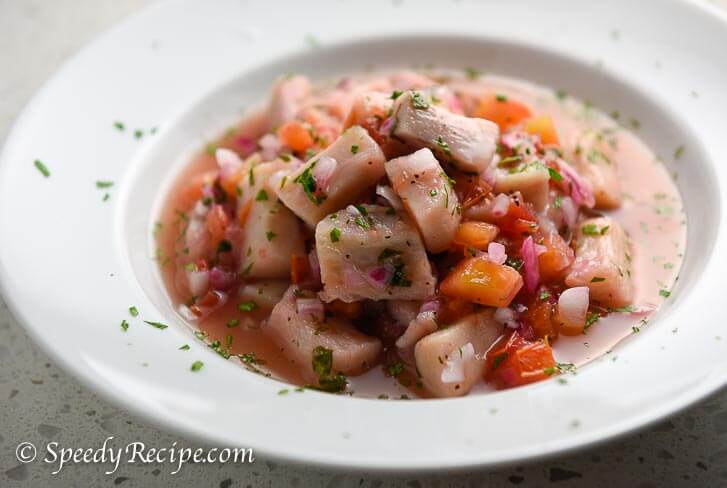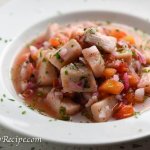Fish ceviche is widely enjoyed throughout Peru, often seen in casual markets, beachside kiosks, and everyday households. It’s common during lunchtime, especially in coastal towns where fishermen bring in the catch of the day in the early morning.

I usually prepare this when I crave something sharp and cool, especially when served with cold beer or plain rice. In the Philippines, fish ceviche is always accompanied by cold beers and grilled meats. What draws me to this version is how speedy it comes together. No fire. Just simple chopping, mixing, and waiting. I adjusted the salt to match how I want the citrus to punch through. I also chilled it just long enough to preserve the freshness while letting the acids do their job.
What is Fish Ceviche?
Fish ceviche is a no-cook dish where raw fish cubes get soaked in citrus juice until the flesh turns opaque. The acid from lemon or lime does the work that heat normally would. The word “ceviche” likely comes from the Spanish word “escabeche,” referring to something marinated in acid or vinegar.
In Peru, where this dish is practically a national treasure, it’s often the first plate to disappear at lunch. It spread across Latin America and beyond because the method is fast, the ingredients are simple, and the results depend more on freshness than technique.
One thing people often don’t know is that the fish doesn’t stay raw after sitting in lemon juice for a few hours. It firms up and whitens just like it would with heat. A common mistake is assuming any fish will do, but this method demands the freshest fillets possible. Using older fish or previously frozen in fish ceviche cuts can affect both safety and taste. Parasites and bacteria don’t always get killed by acid, so you need sushi-grade or fresh day-caught fish. I always inspect the smell and firmness, if it doesn’t smell clean or has mushy parts, it won’t work here.
Sour, cold, and sharp, it’s time to meet the ingredients that let this dish speak for itself.

Ingredients of Fish Ceviche
- Fish fillet (4 ounces) – This is the base of the dish. Choose white fish with firm flesh like sea bass or snapper. Freshness matters more than anything. I always go for sushi-grade or day-caught fish with no fishy smell.
- Red onion (1, minced) – Sharp and crunchy, this cuts through the citrus. I usually soak the minced onion in ice water for 10 minutes to take the edge off without losing its clean flavor.
- Plum tomato (1, cored and chopped) – It adds a hint of sweetness and moisture. I remove the seeds to keep the bowl from turning soggy.
- Lemon (2 pieces) – The juice from the lemons “cooks” the fish. I squeeze and strain the juice by hand so no pulp or seeds sneak in.
- Cilantro (¼ cup, chopped) – This gives the dish its green lift. I chop it just enough so it blends well and doesn’t overpower the fish.
- Salt (½ teaspoon) – Essential for drawing out the moisture from the fish. It also tightens the flavors in the citrus base.
- Ground black pepper (⅛ teaspoon) – Adds a little edge. I grind it fresh to get the cleanest aroma and flavor in every bite.
How This Fish Ceviche Stands Out
Some fish ceviche recipes use use bottled lemon juice, which cuts down on prep but weakens the result. Others overload the mix with extra vegetables or use sweeteners, which changes the focus away from the fish. My version keeps things clean. I use only what enhances the fish, nothing more. That includes fresh lemon juice, quality fillets, and just enough tomato and onion for contrast.
How to Make Fish Ceviche
- Cut and check your fish – Slice 4 ounces of fish fillet into small cubes, about bite-sized. The size matters because the acid needs to reach all sides evenly. I inspect the texture and smell of the fish before anything else. If the flesh feels firm and smells clean, it’s ready for the bowl.
- Add the citrus bath – Transfer the cubed fish to a clean mixing bowl. Squeeze juice from 2 lemons directly over the fish. Stir the mixture gently so every piece is covered. I avoid metal bowls here to keep the acid from reacting and changing the flavor.
- Mix in the first vegetables – Drop in the minced red onion and chopped plum tomato. The acid starts softening the onion while the tomato blends into the juice. I stir this part slowly with a spoon to keep the tomato pieces from falling apart. It starts to smell brighter right away.
- Add the herbs – Sprinkle in ¼ cup of chopped cilantro. I like to chop it fresh right before adding so it holds the green color longer. This is where the freshness really starts to lift. Stir it gently into the mix until evenly scattered.
- Season with care – Add ½ teaspoon of salt and ⅛ teaspoon of ground black pepper. The salt helps draw liquid from the fish and vegetables while locking in the citrus. I taste the juice at this point to decide if it needs another pinch of salt. Freshly ground pepper gives it just enough bite.
- Seal and chill – Cover the bowl tightly with plastic wrap. Move it to the refrigerator and leave it there for at least 3 hours. Overnight is better if you want deeper acid contact. The fish will change color slightly and turn firm as it rests.
- Serve it cold – Remove the bowl from the fridge just before serving. Stir once more to check for even coating. I usually serve it directly in small chilled bowls or over plain rice. You’ll know it’s ready when it smells citrusy, not fishy. Enjoy the fish ceviche!
What to Have with Fish Ceviche
I love pairing fish ceviche with dishes that bring contrast or comfort to the table. Its tangy citrus flavor shines when I serve it alongside crisp or creamy sides that locals enjoy in coastal Latin America.
- Tortilla chips or tostadas – These sturdy crunchers scoop up fish and juice with ease. Many people set out chips and small bowls of salsa for dipping While I don’t have plain tostadas, I’m proud of my taco bake here.
- Plantain chips – Popular in Ecuador and Peru, these thin, fried chips hold up well and add a salty complement. Try this banana chips recipe.
- Avocado salad – Sliced or in salad form, avocado brings creamy contrast to the citrus bite.
- White rice or cilantro-lime rice – A neutral base that rounds out the sharp flavors while giving a fuller meal.
- Grilled meats – This is not a traditional pairing, but this is a common sight in other regions. For example, in the Philippines, a ceviche is there when there’s grilled meats. Try grilled pork belly or chicken inasal.
These pairings work well at lunch or light dinner, and they help spread the bright fish flavor across the table. Fish ceviche never stands alone, and it tastes even better when shared.
Fish Ceviche
Ingredients
- 4 ounces fish fillet
- 1 red onion minced
- 1 plum tomato cored and chopped
- 2 pieces lemon
- ¼ cup cilantro chopped
- 1/2 teaspoon salt
- 1/8 teaspoon ground black pepper
Instructions
- Slice the fish fillet into cubes.4 ounces fish fillet
- Arrange the cubed fish in a bowl. Squeeze the lime over the fish. Mix well.2 pieces lemon
- Add the onion and tomato. Mix1 red onion, 1 plum tomato
- Add the cilantro. Mix well.¼ cup cilantro
- Put the salt and pepper into the mixture. Continue to mix using a spoon until all the ingredients are well blended.1/2 teaspoon salt, 1/8 teaspoon ground black pepper
- Cover the bowl with a plastic wrap and then place it in the refrigerator. Refrigerate for at least 3 hours (overnight is preferred).
- Serve chilled. Enjoy!
Video

Notes
- Use only sushi-grade or day-caught fish. Acid from lemon juice does not fully kill harmful bacteria or parasites. If you’re buying from a market, ask when the fish was caught and request cuts suitable for raw dishes. Avoid anything that smells off or looks slimy. I prefer snapper or sea bass because the flesh stays firm even after chilling.
- Soak the onion briefly before mixing. Red onions can be harsh and overpowering. To soften that edge, I soak the minced onion in ice water for about 10 minutes before using. This method helps retain crunch while making the bite milder and more enjoyable. Don’t skip this if you want clean flavor.
- Always strain the lemon juice. Pulp and seeds can disrupt the mix and make the juice cloudy. I squeeze the lemons by hand through a small mesh strainer. It takes a little more effort but gives better clarity in both texture and taste.
- Don’t over-marinate. Fish ceviche hits its best stage after 3 to 4 hours in the fridge. If left overnight, it still works—but the fish starts turning firmer and a bit drier. Anything beyond 24 hours and it starts breaking down too much. I suggest checking the firmness with a fork before serving.
- Avoid metal bowls. Citrus reacts with metal and can leave a strange aftertaste. Stick with glass or ceramic bowls. I use one with a tight-fitting lid so I can cover it without touching the surface of the fish.


Leave a Reply